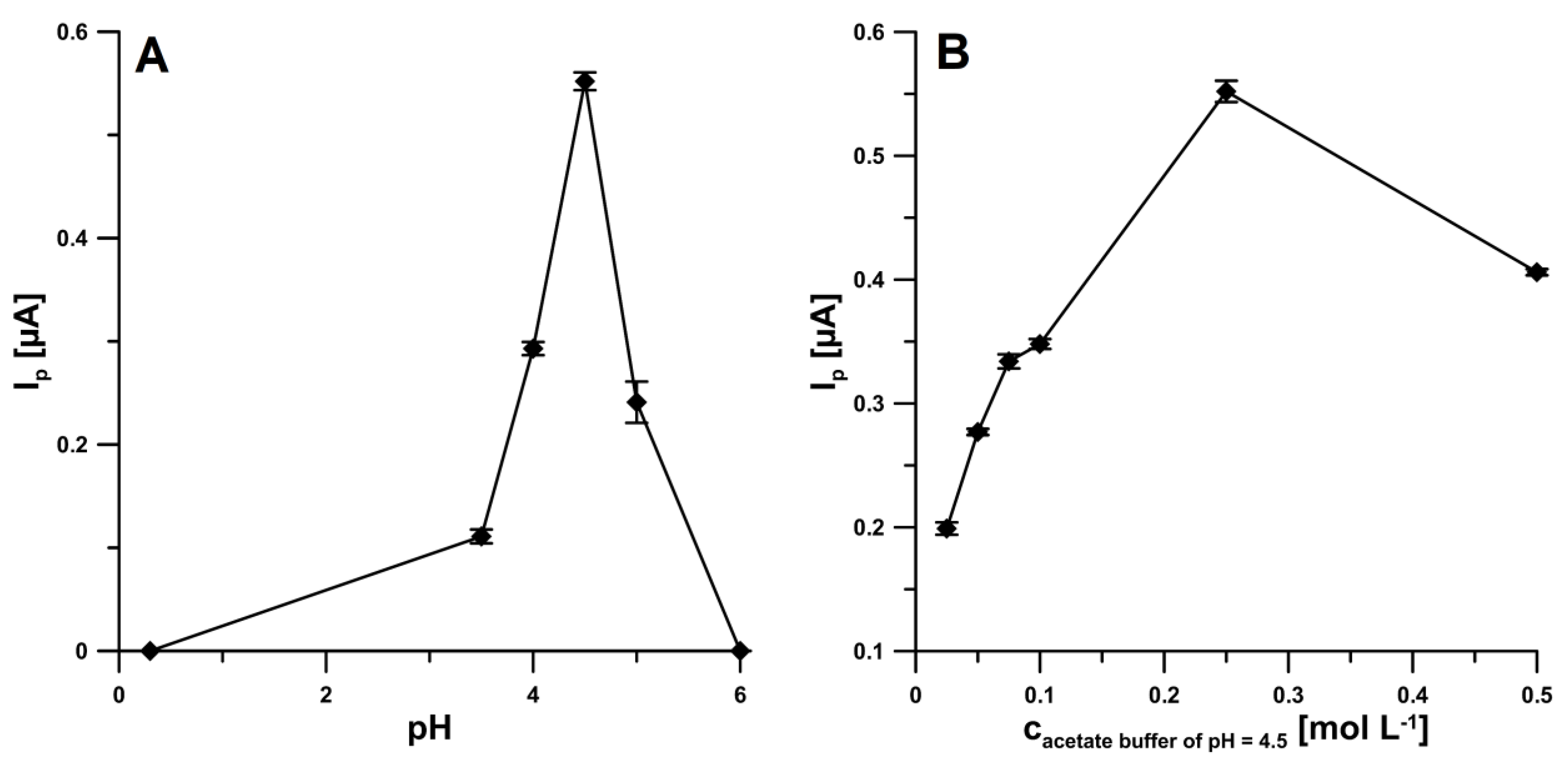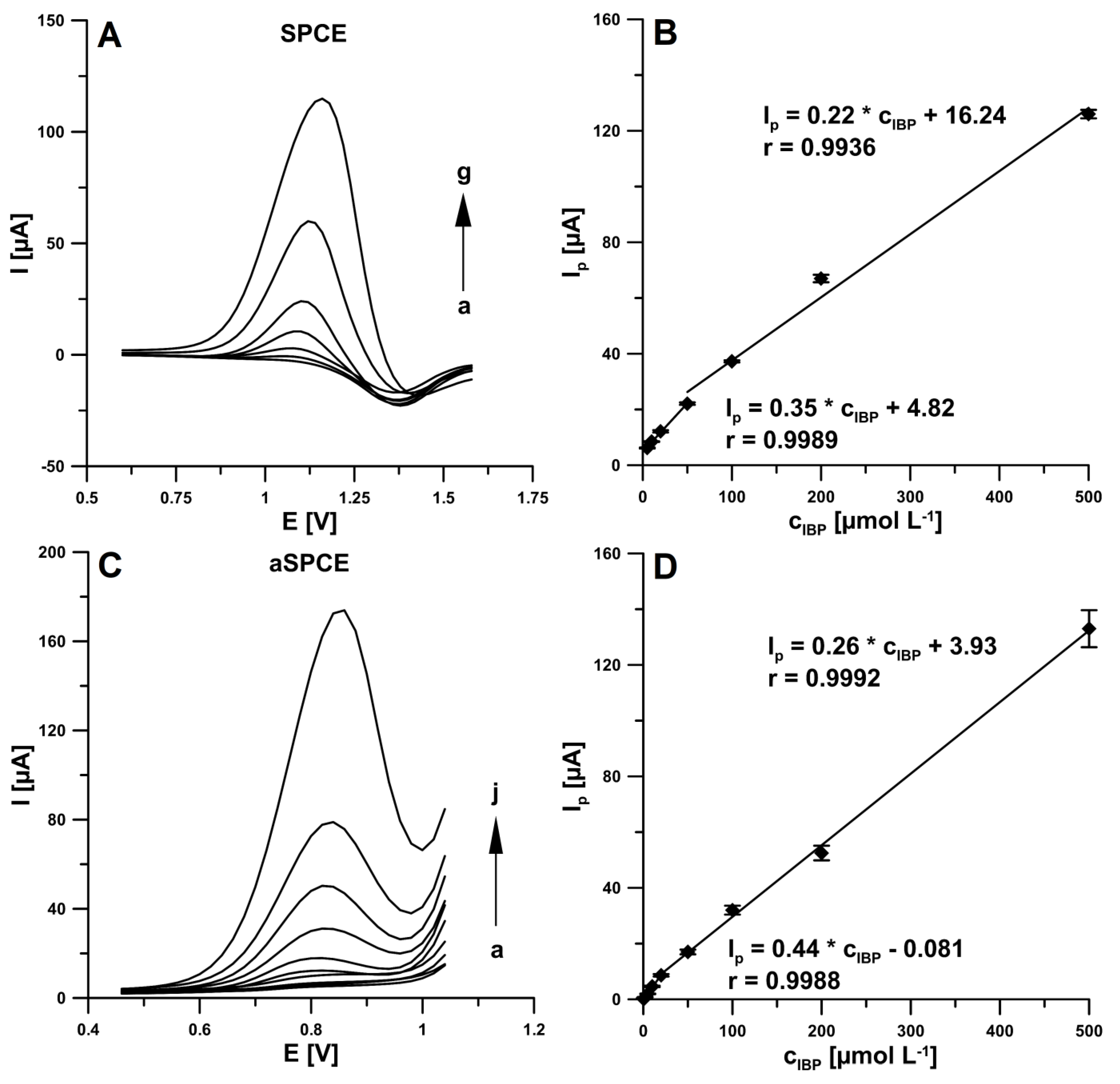Electrochemically Activated Screen-Printed Carbon Electrode for Determination of Ibuprofen
Abstract
:1. Introduction
2. Materials and Methods
2.1. Apparatus and Regents
2.2. Preparation of aSPCE
2.3. Ibuprofen (IBP) Analysis
2.4. Pharmaceutical Formulations
3. Results and Discussion
3.1. Electrochemical Behaviour of IBP
3.2. Optimization of pH and Supporting Electrolyte Concentration
3.3. Optimization of DPV Parameters
3.4. Analytical Characteristic (LOD, LOQ, Repeatability, Reproducibility and Selectivity)
3.5. Application
4. Conclusions
Author Contributions
Funding
Institutional Review Board Statement
Informed Consent Statement
Data Availability Statement
Conflicts of Interest
References
- Yilmaz, B.; Erdem, A.F. Determination of ibuprofen in human plasma and urine by gas chromatography/mass spectrometry. J. AOAC Int. 2014, 97, 415–420. [Google Scholar] [CrossRef] [PubMed]
- Mohammadnejad, M. Simultaneous determination of ibuprofen and caffeine in urine samples by combining MCR-ALS and excitation-emission data. Anal. Bioanal. Chem. Res. 2016, 3, 123–130. [Google Scholar]
- Wang, Q.-L.; Xie, J.; Li, X.-D.; Ding, L.-S.; Liang, J.; Pei, L.; Qing, L.-S. Development of a nano-SiO2 based enzyme-linked ligand binding assay for the determination of ibuprofen in human urine. Talanta 2017, 167, 617–622. [Google Scholar] [CrossRef] [PubMed]
- Bushra, R.; Aslam, N. An overview of clinical pharmacology of ibuprofen. Oman Med. J. 2010, 25, 155–161. [Google Scholar] [CrossRef] [PubMed]
- Puangpetch, A.; Limrungsikul, A.; Prommas, S.; Rukthong, P.; Sukasem, C. Development and validation of a liquid chromatography-tandem mass spectrometry method for determination of ibuprofen in human plasma. Clin. Mass Spectrom. 2020, 15, 6–12. [Google Scholar] [CrossRef]
- Türk, S.C.; Şatana, E.; Basan, H.; Göǧer, N.G. Determination of ibuprofen and paraben in pharmaceutical formulations using flow-injection and derivative spectrophotometry. J. Anal. Chem. 2015, 70, 50–54. [Google Scholar] [CrossRef]
- Han, Z.; Lu, L.; Wang, L.; Yan, Z.; Wang, X. Development and Validation of an HPLC Method for Simultaneous Determination of Ibuprofen and 17 Related Compounds. Chromatographia 2017, 80, 1353–1360. [Google Scholar] [CrossRef]
- Borahan, T.; Unutkan, T.; Şahin, A.; Bakırdere, S. A rapid and sensitive reversed phase-HPLC method for simultaneous determination of ibuprofen and paracetamol in drug samples and their behaviors in simulated gastric conditions. J. Sep. Sci. 2019, 42, 678–683. [Google Scholar] [CrossRef] [PubMed]
- Ragab, M.A.A.; Abdel-Hay, M.H.; Ahmed, H.M.; Mohyeldin, S.M. Application of capillary zone electrophoresis coupled with a diode array detector (CZE-DAD) for simultaneous analysis of ibuprofen and phenylephrine. J. AOAC Int. 2019, 102, 473–479. [Google Scholar] [CrossRef] [PubMed]
- Švorc, L.; Strežová, I.; Kianičková, K.; Stanković, D.M.; Otřísal, P.; Samphao, A. An advanced approach for electrochemical sensing of ibuprofen in pharmaceuticals and human urine samples using a bare boron-doped diamond electrode. J. Electroanal. Chem. 2018, 822, 144–152. [Google Scholar] [CrossRef]
- EL Ouafy, H.; El Ouafy, T.; Oubenali, M.; EL Haimouti, A.; Gamouh, A.; Mbarki, M. Electrocatalytic effect of Al2O3 supported on clay in oxidizing of ibuprofen at graphite electrode. Metods Objects Chem. Anal. 2021, 16, 81–87. [Google Scholar] [CrossRef]
- Apetrei, I.M.; Bejinaru, A.A.; Boev, M.; Apetrei, C.; Buzia, O.D. Determination of ibuprofen based on screen-printed electrodes modified with carbon nanofibers. Farmacia 2017, 65, 790–795. [Google Scholar]
- Serrano, N.; Castilla, O.; Ariño, C.; Diaz-Cruz, M.S.; Diaz-Cruz, J.M. Commercial screen-printed electrodes based on carbon nanomaterials for a fast and cost-effective voltammetric determination of paracetamol, ibuprofen and caffeine in water samples. Sensors 2019, 19, 4039. [Google Scholar]
- Amin, S.; Soomro, M.T.; Memon, N.; Solangi, A.R.; Qureshi, S.T.; Behzad, A.R. Disposable screen printed graphite electrode for the directelectrochemical determination of ibuprofen in surface water. Environ. Nanotechnol. Monit. Manag. 2014, 1–2, 8–13. [Google Scholar]
- Kozak, J.; Tyszczuk-Rotko, K.; Wójciak, M.; Sowa, I.; Rotko, M. First screen-printed sensor (electrochemically activated screen-printed boron-doped diamond electrode) for quantitative determination of rifampicin by adsorptive stripping voltammetry. Materials 2021, 14, 4231. [Google Scholar] [CrossRef] [PubMed]
- Strzemski, M.; Wójciak-Kosior, M.; Sowa, I.; Kocjan, R.; Tyszczuk-Rotko, K. Methodological approach to determine carlina oxide—A main volatile constituent of Carlina acaulis L. essential oil. Talanta 2019, 191, 504–508. [Google Scholar] [CrossRef] [PubMed]
- Mocak, J.; Bond, A.M.; Mitchell, S.; Scollary, G. A statistical overview of standard (IUPAC and ACS) and new procedures for determining the limits of detection and quantification: Application to voltammetric and stripping techniques. Pure Appl. Chem. 1997, 69, 297–328. [Google Scholar] [CrossRef]




| Method | Linear Range (µM) | LOD (µM) | Reference |
|---|---|---|---|
| Spectrophotometry | 1940.0–5800.0 | 134.0 | [6] |
| RP-HPLC | 3880.0–5820.0 | 0.39 | [7] |
| RP-HPLC | 1.21–1210.0 | 0.29 | [8] |
| CZE | 24.20–969.0 | 7.17 | [9] |
| DPV (BDDE) SWV (BDDE) | 0.949–66.90 | 0.41 0.93 | [10] |
| DPV (CNF/SPCE) | 0.80–30.0 | 0.35 | [12] |
| DPV (aSPCE) | 0.50–20.0 20.0–500.0 | 0.059 | This work |
| Tablets | Label Value (mg) | Determined DPV (mg) ± SD (n = 3) | Relative Error * (%) |
|---|---|---|---|
| 1 | 200.0 | 209.3 ± 1.0 | 4.7 |
| 2 | 200.0 | 206.2 ± 4.1 | 3.1 |
Publisher’s Note: MDPI stays neutral with regard to jurisdictional claims in published maps and institutional affiliations. |
© 2021 by the authors. Licensee MDPI, Basel, Switzerland. This article is an open access article distributed under the terms and conditions of the Creative Commons Attribution (CC BY) license (https://creativecommons.org/licenses/by/4.0/).
Share and Cite
Tyszczuk-Rotko, K.; Kozak, J.; Węzińska, A. Electrochemically Activated Screen-Printed Carbon Electrode for Determination of Ibuprofen. Appl. Sci. 2021, 11, 9908. https://doi.org/10.3390/app11219908
Tyszczuk-Rotko K, Kozak J, Węzińska A. Electrochemically Activated Screen-Printed Carbon Electrode for Determination of Ibuprofen. Applied Sciences. 2021; 11(21):9908. https://doi.org/10.3390/app11219908
Chicago/Turabian StyleTyszczuk-Rotko, Katarzyna, Jędrzej Kozak, and Anna Węzińska. 2021. "Electrochemically Activated Screen-Printed Carbon Electrode for Determination of Ibuprofen" Applied Sciences 11, no. 21: 9908. https://doi.org/10.3390/app11219908
APA StyleTyszczuk-Rotko, K., Kozak, J., & Węzińska, A. (2021). Electrochemically Activated Screen-Printed Carbon Electrode for Determination of Ibuprofen. Applied Sciences, 11(21), 9908. https://doi.org/10.3390/app11219908






